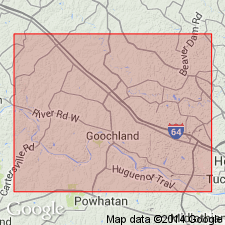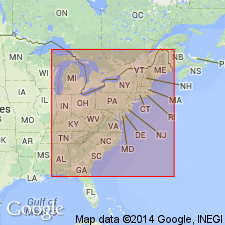
- Usage in publication:
-
- State Farm gneiss
- Modifications:
-
- Named
- Dominant lithology:
-
- Gneiss
- AAPG geologic province:
-
- Piedmont-Blue Ridge province
Summary:
Named for typical outcrops near State Farm, Goochland Co., central VA. Consists of light- to dark-gray, medium-grained, relatively uniform, evenly banded gneiss with well-developed foliation. Age is Precambrian.
Source: GNU records (USGS DDS-6; Reston GNULEX).

- Usage in publication:
-
- State Farm Gneiss*
- Modifications:
-
- Overview
- Geochronologic dating
- AAPG geologic province:
-
- Piedmont-Blue Ridge province
Summary:
Grenvillian [Middle Proterozoic] rocks cropping out in eastern Piedmont of VA in region called Goochland terrane by Horton and others (1989) or Goochland granulite terrane by Farrar (1984). Lithic sequence (ascending) consists of State Farm Gneiss (felsic to intermediate gneisses of both igneous and sedimentary protoliths), Sabot Amphibolite (mafic volcanic protolith), and Maidens Gneiss (heterogeneous unit that is probably metavolcanic and metasedimentary in origin). State Farm Gneiss has Rb-Sr whole-rock age of 1031+/-94 Ma (Glover, 1989).
Source: GNU records (USGS DDS-6; Reston GNULEX).
For more information, please contact Nancy Stamm, Geologic Names Committee Secretary.
Asterisk (*) indicates published by U.S. Geological Survey authors.
"No current usage" (†) implies that a name has been abandoned or has fallen into disuse. Former usage and, if known, replacement name given in parentheses ( ).
Slash (/) indicates name conflicts with nomenclatural guidelines (CSN, 1933; ACSN, 1961, 1970; NACSN, 1983, 2005, 2021). May be explained within brackets ([ ]).

